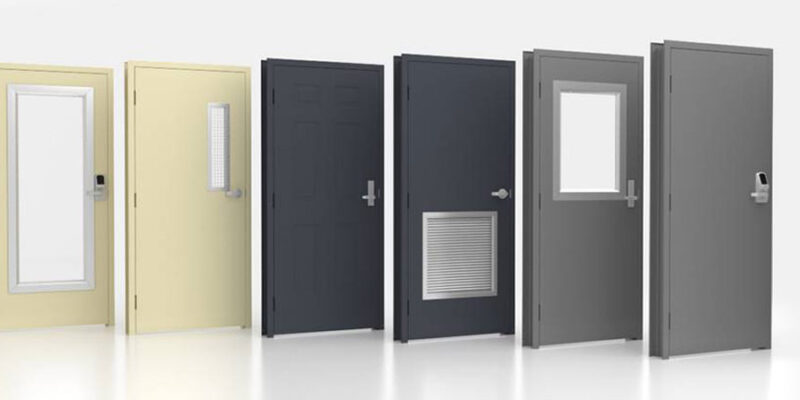In the world of commercial construction, durability remains one of the top considerations when selecting building components, especially entry systems. Hollow metal doors, constructed primarily from steel or galvanized materials, offer an unmatched level of toughness and resilience, notes Dallas Property Management Solutions. These doors are built to endure high-frequency usage, making them ideal for environments such as schools, hospitals, warehouses, and office buildings where constant foot traffic is the norm. Unlike wood or fiberglass alternatives, metal doors resist warping, cracking, and delamination, ensuring years of dependable service.
Additionally, the inner core of these doors—often filled with materials like steel stiffeners, polyurethane, or honeycomb cardboard—plays a critical role in reinforcing their structural integrity. This internal reinforcement not only improves impact resistance but also adds to thermal and acoustic insulation. The result is a well-rounded solution that maintains its shape and function even under duress. Property managers and building engineers find this especially valuable when managing large facilities where maintenance efficiency is a top concern.
From a long-term investment perspective, hollow metal doors also provide a lower total cost of ownership. While the initial purchase price may appear marginally higher than other materials, the extended lifecycle, reduced maintenance demands, and minimal repair frequency quickly offset the upfront expense. These doors are purpose-built for longevity, which aligns with the financial objectives of many commercial real estate developers and facility managers looking for cost-effective solutions over time.
Unmatched Fire and Safety Ratings
When it comes to ensuring the safety of occupants and compliance with local building codes, hollow metal doors offer a distinct advantage. These doors can be rated for up to three hours of fire resistance, depending on their construction and certification. That level of protection makes them indispensable in buildings where fire containment and emergency egress are critical. In facilities such as hospitals and manufacturing plants, these doors can act as a barrier that slows the spread of fire and smoke, providing crucial extra minutes for evacuation and emergency response.
Many fire-rated hollow metal doors are engineered with specially insulated cores and fire-resistant components that meet the rigorous standards set by regulatory bodies like UL (Underwriters Laboratories) and NFPA (National Fire Protection Association). Their ability to integrate seamlessly with fire-rated hardware, including closers, panic bars, and intumescent seals, enhances the overall efficacy of a building’s fire safety strategy. Importantly, these doors do not sacrifice aesthetics or accessibility in the pursuit of safety. Manufacturers now offer a wide range of finishes and customizations to match interior and exterior design plans.
Incorporating fire-rated solutions into a building’s entryways not only protects lives but also reduces liability for property owners. Insurance companies often provide better rates for properties equipped with certified fire doors, recognizing the decreased risk profile. Furthermore, safety audits and inspections become more straightforward when reliable, compliant doors are installed throughout the facility. For contractors and architects seeking premium-grade entry systems that meet fire code and insurance criteria, hollow metal doors remain a clear front-runner.
Enhanced Security Capabilities for Modern Threats
Security remains a top priority for commercial property owners, especially in sectors vulnerable to unauthorized access or vandalism. Hollow metal doors, known for their robust construction, serve as an effective first line of defense against intrusion. Unlike wood or aluminum alternatives, which can be compromised more easily under force, metal doors are far more resistant to tampering and break-ins. This makes them a popular choice for government buildings, correctional facilities, and data centers, where access control is paramount.
These doors can be integrated with advanced locking mechanisms, including mortise locks, electric strikes, and keycard systems. Reinforced frames and hinge attachments add another layer of protection by reducing the likelihood of tampering or structural failure. The versatility in hardware compatibility means that security upgrades or retrofits can be performed without significant modifications, preserving the door’s core structure while adapting to emerging security technologies. In an age where cyber-physical threats are on the rise, the physical security afforded by hollow metal doors remains a cornerstone of a comprehensive risk management plan.
For businesses seeking a reliable and nationally accessible provider of such high-security entry solutions, options such as commercial metal doors and hollow metal door frames from USA Fire Door offer a balance of durability, fire safety, and secure access. USA Fire Door, a respected name in commercial door distribution, supplies solutions tailored for rigorous environments and complex security specifications. Their nationwide reach ensures that building professionals across the United States can source compliant and high-performance hollow metal doors with confidence.
Energy Efficiency and Environmental Responsibility
In recent years, commercial buildings have come under increasing pressure to reduce energy consumption and meet stricter environmental standards. Hollow metal doors contribute meaningfully to these efforts by offering exceptional thermal performance. Insulated cores such as polyurethane or mineral core materials provide high R-values, effectively minimizing heat loss or gain. This makes them a preferred option in climate-controlled facilities, where maintaining consistent interior temperatures is crucial for both comfort and energy savings.
The steel used in hollow metal doors is often recycled and recyclable, supporting broader sustainability initiatives in the construction sector. Many manufacturers now source materials from suppliers that meet environmental certifications such as LEED (Leadership in Energy and Environmental Design). This alignment with green building practices allows developers to earn points toward LEED certification, contributing to a more sustainable commercial infrastructure. Moreover, the long lifecycle of these doors reduces the frequency of replacements and associated material waste, further enhancing their eco-friendly profile.
Another advantage lies in the ability to customize hollow metal doors with energy-efficient features such as thermal breaks and weatherstripping. These enhancements significantly reduce air infiltration, which is especially important in regions with extreme weather conditions. As commercial building codes evolve to emphasize energy conservation, hollow metal doors are proving to be not only practical but also forward-thinking additions to the modern built environment.
Design Versatility and Aesthetic Flexibility
While traditionally associated with utilitarian applications, hollow metal doors have evolved considerably in design flexibility. Modern manufacturing techniques allow for a variety of finishes, profiles, and configurations that can suit a wide range of architectural styles. Whether a project requires a sleek, contemporary appearance or a more industrial look, manufacturers offer finishes including powder coating, baked enamel, and even simulated wood grain. These options enable architects to match the visual intent of a building without compromising on functionality.
Glazing options, including vision lites and full glass panels, further expand the design potential of hollow metal doors. This is particularly valuable in educational, healthcare, and commercial office settings, where visibility and natural light are often prioritized. Beyond aesthetics, these customizations also serve practical purposes, such as improving safety through visibility or contributing to a building’s daylighting strategy. As commercial spaces become more employee- and visitor-centric, the need for entry systems that combine form and function continues to grow.
Furthermore, hollow metal doors can be fabricated to meet unique size and shape requirements, including double door setups, arched frames, and integrated transoms. This makes them suitable for both retrofit and new construction projects with demanding architectural specifications. The ability to combine high-performance materials with bespoke design elements reinforces the growing appeal of these doors across diverse sectors, from hospitality to logistics.
Compliance, Customization, and Long-Term Value
Compliance with regulatory standards is non-negotiable in commercial construction, and hollow metal doors consistently meet or exceed industry benchmarks. These doors are manufactured under strict quality control measures to conform with national standards for fire resistance, accessibility (ADA compliance), and safety. Whether the application requires storm-rated doors in hurricane zones or sound-rated options for broadcast studios, hollow metal doors are often the default choice due to their adaptability and testing credentials.
In addition to compliance, customization is a key factor in their appeal. Commercial building requirements are seldom uniform, and the ability to tailor door specifications—including core materials, frame designs, louver inserts, and hardware cutouts—adds significant value. This level of customization allows project stakeholders to address both performance and aesthetic criteria without sacrificing build quality. Many manufacturers also offer support for BIM (Building Information Modeling) to streamline the design process and minimize installation errors.
The long-term value of hollow metal doors is underscored by their minimal maintenance needs and enduring performance. Routine inspections and occasional refinishing typically suffice to keep them operational for decades. Their ability to withstand abuse, weather, and environmental stress without requiring frequent repairs translates into lower life-cycle costs and improved return on investment. For commercial property owners balancing upfront costs with operational efficiency, hollow metal doors remain a smart, strategic choice.










